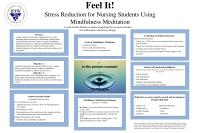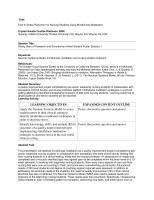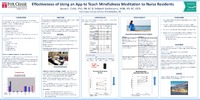| dc.description.abstract | Session presented on Sunday, September 18, 2016: This presentation will address mindfulness meditation as a quality improvement project completed by two senior leadership nursing students in collaboration with preceptors who were clinical faculty leading 200-level nursing students in a clinical setting, along with the course professor. An assessment of needs was completed and a mutually identified topic was agreed upon to be completed within the time frame of a 15-week semester. In working with beginning nursing students, there were many aspects of care and floor nursing that were new and exciting to them, and some were overwhelming and stressful. Educational needs of 200-level students and degree of coaching support required were assessed. In addition to addressing the potential needs of the students, the need for quality improvement (QI) in their clinical practices was also considered. The Neuman Systems Model (NSM) was used to assess needs and stressors of the beginning nursing students. These needs were then prioritized. Specifically, intrapersonal stress related to 'fear' of initiating patient conversation, performing new skills, and entering the room of an adult client in the complex and fast-paced environment of the medical/surgical unit was identified as the highest stressor. To address these fears, evidence-based mindfulness meditation strategies were applied in a teaching project, ongoing coaching during weekly clinicals, and evaluation through conversation and written journal reflections. With this level of nursing students, it became apparent that concrete techniques were required over abstract and more undefined methods to decrease stress and increase therapeutic relationships during clinical. A literature review identified three mindfulness meditation techniques used to decrease student stress. The techniques need to be personalized and understood in order for the student to implement them into their clinical experience. The project itself consisted of a short oral presentation, including education and instruction on mindfulness meditation, followed by discussion and a question and answer period. This teaching methodology was specifically chosen to keep the session personal, interactive, and responsive to student reactions to the strategies that target their fears. Mindfulness meditation and the focus on its use in stress reduction in the United States has been frequently attributed in part to the Mindfulness Based Stress Reduction (MBSR) program developed by Jon Kabat-Zinn at the University of Massachusetts in 1979 (The Greater Good Science Center, 2016). As a Professor of Medicine Emeritus, Kabat-Zinn emphasizes the importance of mindfulness meditation for those in healthcare careers (Kabat-Zinn & Gazella, 2005). Dr. Kabat-Zinn explains that this form of mindfulness is not something that just happens, but is something that needs to be taught, developed, practiced, and maintained (Kabat-Zinn & Gazella, 2005, p. 60). The mindfulness meditation strategies determined appropriate for this audience consist of three specific techniques used to focus the student on the physical feeling of their body for a brief moment, to help bring them into that exact moment without focusing on other tasks, and establishing connection with what is to be done at present. Dr. Kabat-Zinn primarily discusses how the technique of 'watching' one's own breath helps to center the student, connect them with their physical self, and create mindfulness by focusing on the present moment (The Greater Good Science Center, 2016). 'Watching' a breath can be done in a variety of ways, depending on how and where the individual physically feels their breath, and focusing their attention to that point (The Greater Good Science Center, 2016; Dr. Brown, personal communication, February 28, 2016). Examples include how the breath feels on the upper lip coming from the nose, how the air feels passing in and out of the nostrils, how the stomach feels when breathing, or the rise and fall of the chest. The two other techniques included have similar grounding effects, and consist of feeling your feet in your shoes and on the floor, or what water on their hands feels like while washing them prior to entering a patient room. As a leadership student, it was critical to establish a trusting relationship and collaborative rapport with underclassmen while providing respectful, positive and corrective feedback. Multiple measures were used to evaluate student knowledge, skills, and attitudes (KSAs) after implementing mindfulness meditation strategies in the real-world clinical setting were used to assess the learning outcomes. Multiple measures included reflective journaling, weekly conversations, and observation of behavior changes in the students. The most meaningful and informative findings were revealed in reflective journaling. The written student journals showed a willingness to reflect on practice and to implement the use of the strategies. Student comments and themes will be included in the poster presentation. In addition, reflections and learning outcomes by the senior leadership students will be reported. | en |






